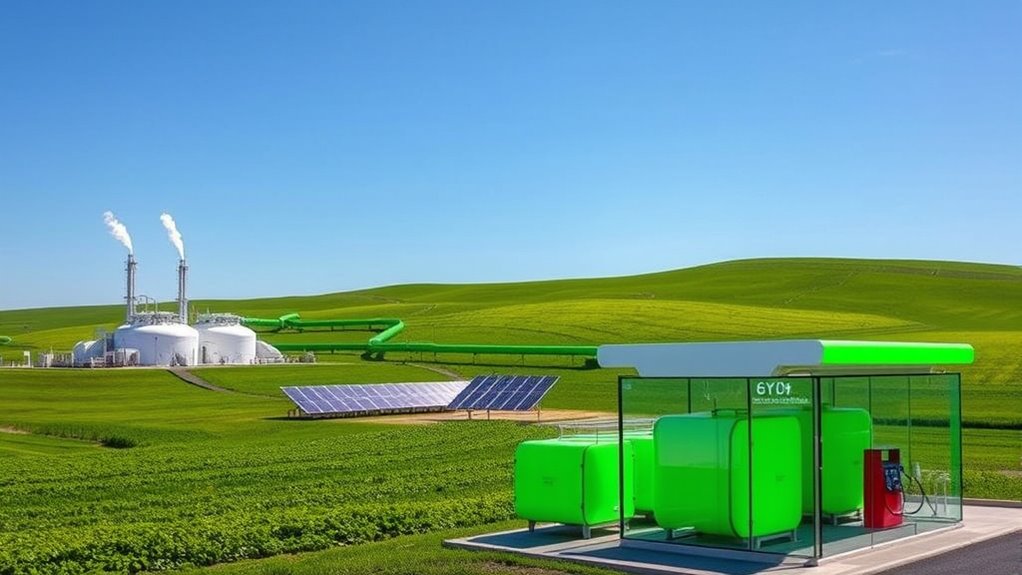Green hydrogen hubs are upcoming infrastructure centers designed to produce, store, and distribute zero-emission hydrogen efficiently. Widespread renewable energy sources like offshore wind and solar power fuel these hubs, integrating with existing infrastructure for cost savings and faster deployment. They support decarbonization in sectors like transportation and industry while fostering regional innovation. By optimizing the entire hydrogen value chain, these hubs are shaping the future of clean energy—discover how they could transform the energy landscape.
Key Takeaways
- Green hydrogen hubs optimize production, storage, and distribution using renewable energy sources like wind and solar.
- Integration with existing infrastructure, such as pipelines and ports, accelerates development and reduces costs.
- Location selection prioritizes regions with high renewable potential and proximity to industries and transportation hubs.
- Technologies like high-efficiency electrolysis enable scalable, cost-effective hydrogen generation for diverse sectors.
- These hubs support decarbonization, energy transition, and the creation of resilient, sustainable regional energy ecosystems.

Green hydrogen hubs are strategically located zones designed to produce, store, and distribute zero-emission hydrogen using renewable energy sources. These hubs serve as concentrated centers that optimize the entire green hydrogen value chain, from generation to end-use. By focusing on specific regions rich in renewable resources like offshore wind or solar power, you can create a reliable supply of clean hydrogen, which is crucial for decarbonizing sectors traditionally dependent on fossil fuels. The goal is to accelerate adoption across industries such as transportation, heavy industry, and power generation, offering a zero-emission alternative that notably reduces greenhouse gas emissions. These hubs also act as innovation zones, fostering collaboration among industries and technological developments within regional ecosystems, which helps streamline processes and reduce costs.
Green hydrogen hubs optimize renewable resources to produce, store, and distribute zero-emission hydrogen, accelerating decarbonization across industries.
Integrating with existing infrastructure is fundamental for the success of hydrogen hubs. You’ll need to upgrade grid systems to handle large-scale hydrogen production demands and guarantee grid stability. Renewable energy can sometimes be curtailed, meaning excess power generated isn’t used; hubs can tap into this surplus to produce hydrogen more economically, improving project viability. Additionally, hydrogen hubs can both draw electricity from the grid to power electrolyzers and supply electricity back to it via hydrogen-powered generators, creating a flexible energy system. Repurposing existing infrastructure, like gas pipelines, industrial sites, and transportation networks, can considerably cut costs and speed up development, making the transition to green hydrogen more feasible and less disruptive.
Moreover, the integration of high-efficiency electrolysis technology can significantly boost hydrogen production efficiency and reduce operational costs, making green hydrogen more competitive. There are primarily two types of hydrogen hub configurations: off-grid and on-grid. Off-grid hubs operate independently, relying solely on renewable energy sources such as wind or solar for electrolysis. These are ideal in regions with abundant renewable resources but limited grid access. On-grid hubs, on the other hand, connect to the national electricity grid, which offers more stable power input and helps maintain consistent electrolyzer operation. Both configurations require different storage capacities and operational setups, depending on supply and demand patterns. Regardless of the type, the focus remains on utilizing high-quality renewable electricity to produce hydrogen efficiently and sustainably.
Location choice is critical. You should consider areas with high renewable energy potential, proximity to industries like steel manufacturing or chemical production, and access to transportation infrastructure such as ports, railways, and roads for distribution. Coastal locations are particularly advantageous for integrating offshore wind power with onshore electrolyzers and facilitating export opportunities. Planning involves clearly defining geographic boundaries and service areas to maximize operational synergy and resource utilization. By strategically positioning these hubs, you can ensure efficient hydrogen production, storage, and distribution, making them central to the future clean energy economy.
Frequently Asked Questions
How Cost-Effective Are Green Hydrogen Hubs Compared to Traditional Energy Sources?
You might wonder how green hydrogen hubs stack up against traditional energy sources. Currently, green hydrogen costs range from $2.83 to $6 per kilogram, mainly driven by renewable electricity prices. While they’re more expensive than natural gas today, policies, subsidies, and falling renewable costs could make green hydrogen more competitive by 2030. However, without significant cost reductions in electricity, full competitiveness may still be decades away.
What Are the Environmental Impacts of Establishing Green Hydrogen Hubs?
You should consider that establishing green hydrogen hubs impacts the environment in several ways. While aiming to reduce emissions, they may strain water resources, especially in water-scarce areas. Building new infrastructure can harm local ecosystems, and if not managed properly, leaks or safety issues could occur. Additionally, siting these hubs in vulnerable communities might worsen existing pollution and health disparities without strong regulations and community engagement.
How Scalable Are Green Hydrogen Hubs for Global Energy Needs?
You’re wondering how scalable green hydrogen hubs are for global energy needs. Currently, their growth depends on regional renewable resources, technological advancements, and policy support. With investments increasing and infrastructure improving, green hydrogen can substantially contribute—potentially reaching 50–65% of global supply by 2050. However, challenges like high costs, storage, and transport infrastructure must be addressed to guarantee widespread scalability and meet future energy demands effectively.
What Are the Key Technological Challenges in Building Hydrogen Infrastructure?
You face key technological challenges in building hydrogen infrastructure. Improving electrolyzer efficiency and reducing costs are crucial, as current tech is still in early stages. Developing advanced fuel cells, enhancing safety systems, and enabling system integration with existing energy networks also pose hurdles. Additionally, blending hydrogen with natural gas and creating scalable storage solutions require innovation. Overcoming these challenges is essential for a reliable, efficient, and safe hydrogen infrastructure.
How Do Policies Influence the Development of Green Hydrogen Hubs?
Policies play a pivotal role in developing green hydrogen hubs by providing clear standards and streamlined regulations, making project deployment easier. They offer financial incentives, grants, and public-private partnerships that attract investments. Additionally, policies support technological innovation and renewable integration, while fostering international cooperation and harmonized standards. This creates a stable environment, encourages industry growth, and accelerates the progression to sustainable hydrogen infrastructure.
Conclusion
As you look toward the future, green hydrogen hubs hold the key to sustainable energy. They’re essential for reducing emissions, powering industries, and transforming transportation. By investing now, you help build a cleaner, greener world. Isn’t it time you embraced the innovation that can make this vision a reality? With collaboration and commitment, you can be part of the shift toward a more sustainable energy landscape. The question is: are you ready to be part of the change?










